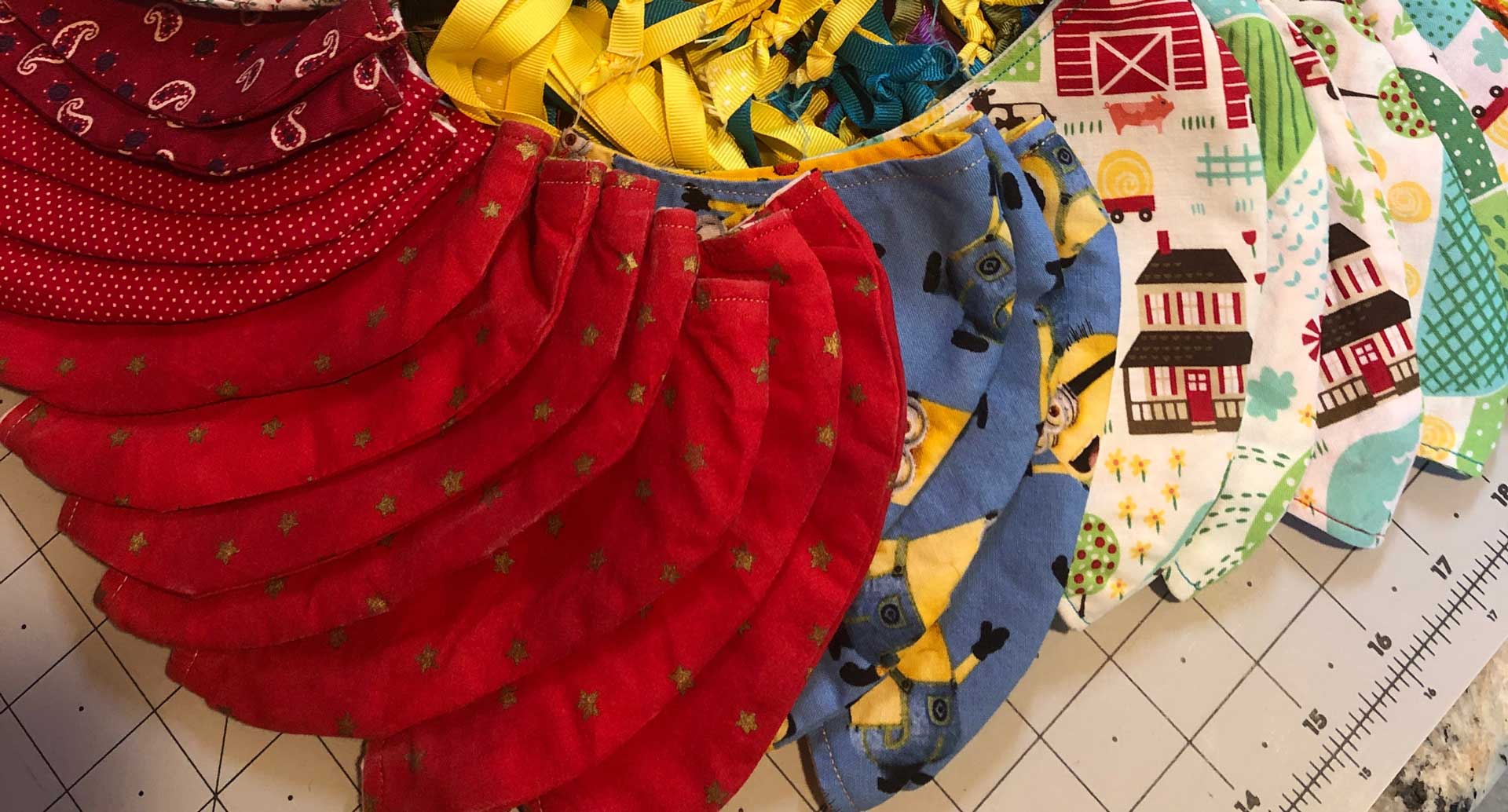 We all handle stressful times differently. Some of us are eating or drinking our way through quarantine. Others are binge watching whatever is left on Netflix. Still others have taken up healthier, socially-distant hobbies such as running.
We all handle stressful times differently. Some of us are eating or drinking our way through quarantine. Others are binge watching whatever is left on Netflix. Still others have taken up healthier, socially-distant hobbies such as running.
HERA Lab Architect Rainey Hufstetler is sewing. And sewing. And sewing.
In her spare time between working from her home office (which also doubles as her sewing room) and helping her daughter complete homework assignments, Rainey is sewing N95 mask covers for Atlanta-area workers who continue working in the public realm, exposing themselves to coronavirus.
How many masks have you made?
I believe I’ve made about 130 masks thus far. The group I’ve donated most of the masks I’ve made to has been able to donate over 20,000 fabric masks to area healthcare providers in just over five weeks.
Where are they going?
About 80 of the masks I made have been donated to Sewing Masks for Area Hospitals – Atlanta, which is a collective of local volunteers self-identified as the ATL Seam-sters. As of today, the group has just under 8,500 members and has been working from patterns modified by nurses at some of Atlanta’s largest hospitals (Emory, Children’s Healthcare of Atlanta and Grady) to provide masks for healthcare workers. In addition to those 80, I’ve also supplied a batch to my neighbor’s infectious disease medical office, a batch to my community grocery store and masks to quite a few friends and family members.
How long do they take you to make?
When I started, each mask took about one hour to complete. I’ve been sewing 20-30 hours per week for the past five weeks, so I’ve become a lot faster in that time. I now sew them in assembly line styled steps in batches of 12+, so I’ve been able to reduce the overall time spent per mask to about 30 minutes each.
How does the assembly line process work?
The pattern I have been using is known as a BaLa mask (The mask’s design was created by two critical care nurses at Grady Health System – Lauren Skinner and Barbara McLean – and is dubbed the “BaLa” mask) and is designed to fit over an N95 face mask as extra protection to extend the life of the medical PPE. BaLa’s also fit really well on non-medical folks who are just looking for a fabric mask that fits securely and doesn’t slide around.
BaLa N95 Cover Pattern_Basic
BaLa_instructions
The assembly line process I’ve been using is as follows:
- Prewash and use all 100% cotton.
- Cut all of the materials together; each mask requires 4 cuts of fabric, so turning the two complementary sets of fabric so that right sides are together, stacking, then cutting allows all 4 pieces to be cut in one pass with a rotary blade
- Sew center curved seams, with fabric set right-sides together. You can do as many of these in a single chain as you like, leaving an inch or so of thread ‘give’ between pieces. The sewn pieces can have the separating threads snipped apart after you finish the first seam.
- Pair up each set of inner and outer mask pieces, right sides together. Finger press (slang for using your fingers to flatten things enough that you can sew them straight) the seams so they nestle closely together. Sew, again in a chain, all of the top seams. Once you have the top seams sewn, reverse the chain an sew all of the bottom seams. Snip all masks back apart once both seams are sewn.
- Turn all of the masks right side out and again finger press the seams so they lay flat enough to topstitch. If you prefer, you can iron. I never iron. Because I hate ironing. Each to their own.
- You can either use elastic or ties. Most of the healthcare workers prefer the ties as the elastic causes fatiguing and sore spots on the ears. I started out making my own ties out of 2” wide fabric strips, formed into bias tape but this took forever so I’ve switched to using grosgrain (not satin) ribbon. Each mask needs 4-20” long ties cut. If using ribbon, knot the ends so it doesn’t unravel. If using fabric/bias tape, stitch the end so it doesn’t fray.
- Turn open edges of the masks in about 3/8”. One tie goes in each corner, so two on each end, inserted also about 3/8” to align with the raw edge of the fabric inside the mask. You can pin the ties in place or just hold until they are sewn. I start on one corner, backstitch over the first tie, then continue to topstitch around the entire perimeter of the mask, about 1/8” in from the edge. Backstitch again at the end to prevent unraveling.
- Once all masks have had their ties added and been topstitched, wash again, dry, and if so inclined, iron before delivering.
Can the masks be used for kids as well as adults?
The BaLa pattern is sized to fit over an N95 filter, so is a bit large on its own. It’s a very simple pattern though, that can be sized up or down as needed. For my daughter, who is six, and for the children of friends, I have scaled down the BaLa pattern by taking about ¾” inch off all sides of the pattern. One side of the pattern is a bit longer than the other; this is the chin side. Particularly for children’s masks, this piece needs to be a bit shorter and more curved to prevent too much gaping at the chin, so I’ve been rounding this end off about 1” from the standard pattern.
What made you start this?
I felt I needed a tangible way to help. Healthcare workers across the U.S. felt an immediate and unprecedented shortage of PPE once the coronavirus began spreading here and began reaching out to friends and family to help provide fabric masks to offset the PPE shortage. Once the CDC (also a HERA client) started recommending that everyone wear a fabric mask when outside their home, I wanted to make sure that I was helping as many people as possible. The fabric masks don’t take the place of an N95 filter, but they help extend the life of the filters in use by providing a replaceable cover and they have been shown to greatly reduce viral load transmission in public places, particularly if worn by infected people. Since the virus is transmissible even between asymptomatic people, the more people that wear the masks, the greater impact we can have on reducing transmission.
What else do you make, outside pandemic times?
During the Australia wildfires at the end of last year and earlier this year, I helped by making Joey pouches for rescued marsupials. In non-apocalyptic, just your average Tuesday kind of times, I enjoy making quilts and the occasional skirt or pair of curtains. Though I’ll be honest, I’ve had my current sewing machine for about five years and 90% of its use has probably come in the past four months.
How long have you been sewing?
I started sewing when I was a kid. My mother is a quilter and my grandmother was a knitter and seamstress. My mother taught me how to quilt when I was around seven, and she’s been teaching my six-year-old daughter as well.
How much material have you used so far?
I’m honestly not sure how many yards of fabric in total. I have been working through what I had on hand, as well as material that has been donated to me to help the effort. It takes about a quarter of a yard for two full masks, so I’d estimate I’ve used about 16-17 yards of fabric and about 10 spools of thread. I’ve also used at least 200 yards of ribbon so far, in addition to the fabric ties I made.
Are you making masks to sell?
No. I’m making them for donation, using what materials I have and what is donated to me. For friends and family that have asked for masks, I’ve asked them to make donations to local charities such as the Atlanta Community Foodbank or the Giving Kitchen, which is an organization that helps service industry members who’ve lost their jobs.
